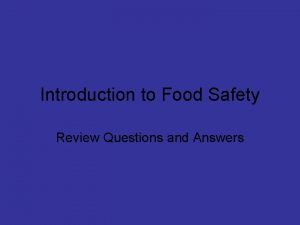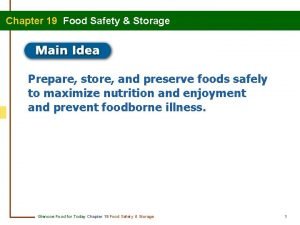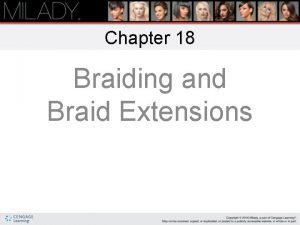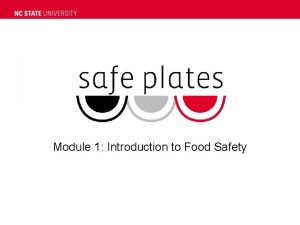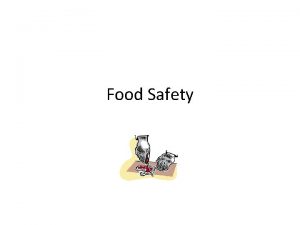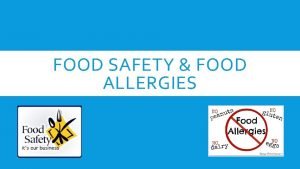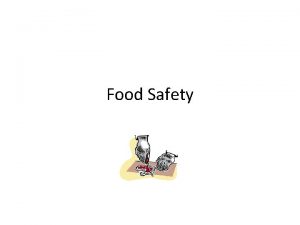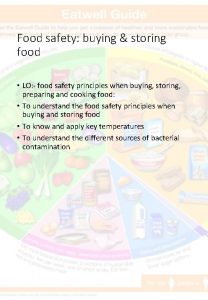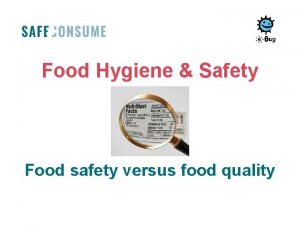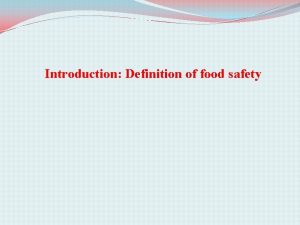Introduction to Food Safety Review Questions and Answers












- Slides: 12

Introduction to Food Safety Review Questions and Answers

What is foodborne illness? • It is a disease that is carried or transmitted to people by food they have eaten.

How many people must experience a foodborne illness before it is considered an outbreak? • At least two or more people must experience the same illness after eating the same food before the incident is considered an outbreak.

What are the costs of foodborne illness? • • Loss of customers and sales. Damage to prestige and reputation. Legal fees. Increased insurance premiums. Lowered employee morale and absenteeism. Need for retraining. Embarrassment. Closure.

Who has a high risk of contracting a foodborne illness? Why? • Infants and preschool-age children. They haven’t built up adequate immune systems, the body’s defense against illness. • Pregnant women. A woman’s immune system is compromised during pregnancy; the health of the fetus she is carrying is also at risk. • The elderly. Their immune systems have weakened with age. • Other populations. This includes people with cancer or on chemotherapy, people with HIV/AIDS, and transplant recipients.

According to the CDC, what are some common risk factors responsible for foodborne illness? • • • Purchasing food from unsafe sources. Holding food at incorrect temperatures. Failing to cook food adequately. Practicing poor personal hygiene. Using contaminated equipment.

What is time-temperature abuse? • Allowing food to remain too long at temperatures favorable to the growth of foodborne pathogens.

What are some examples of how food can be time-temperature abused? • Failing to hold or store food at required temperatures. • Failing to cook or reheat food to temperatures that kill microorganisms. • Failing to cool food properly.

What is cross-contamination? • The transfer of pathogens from one surface or food to another.

What are some examples of when cross-contamination can occur? • When contaminated ingredients are added to food that receives no further cooking. • When cooked or ready-to-eat food is allowed to touch food-contact surfaces that have not been cleaned and sanitized. • When food that may be contaminated is allowed to touch or drip fluids onto cooked or ready-to-eat food. • When a foodhandler touches food that is contaminated and then touches cooked or ready-to-eat food. • When contaminated cleaning cloths are not cleaned and sanitized before being used on other food-contact surfaces.

What are some poor personal hygiene practices that can result in a foodborne illness? • Failing to wash hands properly after using the restroom, or whenever hands become contaminated. • Touching or scratching sores, cuts, or boils, and then touching food, foodpreparation surfaces, or utensils. • Coming to work when sick- for example, with vomiting or diarrhea.

What can be done to prevent foodborne illness? • • Control time and temperature. Prevent cross-contamination. Practice proper personal hygiene. Purchase from approved, reputable suppliers.
 Cross contamination examples
Cross contamination examples Chapter 19 food safety and storage
Chapter 19 food safety and storage Extension fibers hackles and drawing boards
Extension fibers hackles and drawing boards What is food safety
What is food safety Module 1 introduction to food safety
Module 1 introduction to food safety When making smart food choices what question
When making smart food choices what question Food pyramid quiz
Food pyramid quiz Unit 2 food food food
Unit 2 food food food Sequence of food chain
Sequence of food chain Topic 3 review questions civilizations of asia answers
Topic 3 review questions civilizations of asia answers Milady chapter 24 facial makeup pdf
Milady chapter 24 facial makeup pdf In your notebook write questions and short answers
In your notebook write questions and short answers Biotechnology and food safety
Biotechnology and food safety
